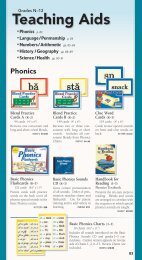Science & Health - A Beka Book
Science & Health - A Beka Book
Science & Health - A Beka Book
You also want an ePaper? Increase the reach of your titles
YUMPU automatically turns print PDFs into web optimized ePapers that Google loves.
<strong>Science</strong>: Earth & Space cont.<br />
Astronomy—Planets cont.<br />
• Saturn:<br />
• Second-largest, “shepherd moons,” Titan, Iapetus, Mimas,<br />
Phoebe<br />
h Enceladus<br />
• Uranus:<br />
• Retrograde rotation<br />
h Titania, Oberon, Miranda, Cordelia, Ophelia<br />
• Neptune: discovered mathematically before seen<br />
h Planets vs. dwarf planets: Pluto and moons, Eris<br />
• Asteroids: asteroid belt, Ceres, Trojan asteroids, near-earth<br />
asteroids<br />
• Comets:<br />
h Edmond Halley<br />
• Halley’s comet, nucleus, coma, tail<br />
h Short-period comet, long-period comet<br />
• Kuiper belt<br />
• Meteoroids: meteor, meteor shower, meteorites<br />
• Constellations:<br />
h Celestial sphere:<br />
h Horizon, distance between objects, celestial poles<br />
h Celestial equator, circumpolar<br />
• Polaris, zodiac<br />
h Modern definition of constellation, asterisms<br />
• Seasonal constellations:<br />
h Spring constellations<br />
h Summer constellations: Lyra, Vega, Summer Triangle<br />
h Autumn and winter constellations<br />
• Great Square<br />
• Southern constellations: Centaurus and Crux<br />
• Sun, stars, and galaxies:<br />
• Sun:<br />
• Core, photosphere, granule, sunspots<br />
h Supergranules<br />
• Chromosphere, spicules, solar flares, solar prominence<br />
h Transition region<br />
• Corona, solar wind<br />
• Stellar measurements:<br />
• Light-year<br />
h Parallax, stellar parallax, parsec<br />
• Star magnitude: apparent magnitude, absolute magnitude<br />
• Star categories:<br />
• Temperature and color, temperature and magnitude<br />
h Hertzsprung-Russell diagram<br />
• Giants, supergiants, main sequence, white dwarfs<br />
h Red dwarfs<br />
• Stars in groups:<br />
• Binary star, optical double<br />
h Open clusters, globular clusters<br />
• Stellar explosions:<br />
• Nova, supernova, pulsar<br />
h Neutron star<br />
• Galaxies:<br />
• Milky Way, clusters, Local Group, Andromeda galaxy<br />
• Superclusters<br />
• Spiral, barred, elliptical, and irregular galaxies<br />
h Lenticular galaxies<br />
<strong>Science</strong><br />
165<br />
h Quasars<br />
• Nebulae<br />
Grade 8<br />
h red indicates NeW MATerIAL<br />
Man & the Universe<br />
• Instruments of astronomy:<br />
• Visible light astronomy:<br />
• Telescope, refracting telescope, objective<br />
• Eyepiece, reflecting telescope<br />
h Resolution<br />
• Spectroscopy: visible spectrum, spectroscope, spectrogram<br />
• Radio wave astronomy:<br />
• Radio telescopes<br />
h Interferometry<br />
• Astronomy and time:<br />
h Meridian and transits: zenith, nadir, meridian, transit<br />
• Day and night:<br />
h Sidereal day<br />
h Apparent solar day, mean solar day, equation of time<br />
• Standard solar time, summer time<br />
• Longer times: lunar month, solar year, week<br />
• Calendars:<br />
• Gregorian<br />
h Julian, Jewish<br />
• Ecliptic and climates:<br />
h Equinox, precession of the equinoxes, solstice<br />
• Climate zones<br />
• Seasons:<br />
h Relationship to equinoxes and solstices; lengths<br />
• Causes<br />
• History of spaceflight:<br />
• Rockets: solid-fuel rocket, Robert Goddard, liquid-fuel rocket,<br />
Wernher von Braun<br />
• Race to the moon:<br />
• Sputnik 1, Explorer 1<br />
• Yuri Gagarin, Alan Shepard, John Glenn, Valentina Tereshkova<br />
• Gemini and Apollo Programs, Saturn V, Neil Armstrong<br />
• Manned space stations: Salyut program, Skylab, Mir, International<br />
Space Station<br />
• Space shuttle<br />
• Spaceflight today:<br />
h Nations in space<br />
• Private space flights<br />
• Orbits and satellites:<br />
• Objects in orbit:<br />
h Apogee, perigee<br />
• Geostationary orbit, polar orbit<br />
h Sun-synchronous orbits, Hohmann transfer orbit<br />
• Unmanned satellites:<br />
• Astronomical, communications, weather, navigational<br />
• Earth observation, military satellites, GPS<br />
• Unmanned space probes:<br />
h Escape velocity<br />
<strong>Science</strong>: Earth & Space cont. p. 166

















